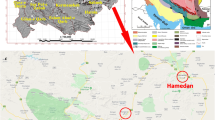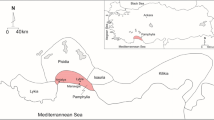Abstract
This article focuses on the petrographic and microfacial characterization of the building stones of buildings, monuments, and quarries of the archeological site of Calakmul to document aspects of composition, lithologies, and stone exploitation. Microfacial analysis shows that the used building rocks are highly recrystallized biosparudites (grainstones to packstones) with the presence of reef and shallow waters fauna (boundstones). These rocks have an intermediate porosity (10–20% pore volume values). XRD analysis confirms that the mineral composition is mainly not only calcite, but also dolomite. Microfacies analysis demonstrates that the limestone of the stelae and the SubII c-1 main façade comes from the same quarry since both have the same textures and microfacial features. Their fine texture corroborates that these stones are suitable for carving and lime production. Microfacial analysis also showed that samples from St. XX Gran Acropolis and from Chan Chi’ich Group come from different quarries. These results help us to identify the origin of the rocks, their use in the buildings and monuments studied, and contribute to the knowledge of their lithological characteristics and their response to weathering in a tropical context. Such aspects are crucial to the decision making for future conservation processes.












Similar content being viewed by others
Availability of data and materials
Data can be requested by emailing the corresponding author.
References
Abrams E (1994) How the Maya built their world: energetics and ancient architecture. University of Texas Press, Austin
Abrams E, Bolland T (1999) Architectural energetics, ancient monuments, and operations management. J Archaeol Method Theory 6:263–291. https://doi.org/10.1023/A:1021921513937
Abrams E, Rue D (1988) The causes and consequences of deforestation among the Prehistoric Maya. Hum Ecol 16:377–395. https://doi.org/10.1007/BF00891649
Bauer-Gottwein P, Gondwe BRN, Charvet G, Marín LE, Rebolledo-Vieyra M, Merediz-Alonso G (2011) Review: the Yucatán Peninsula karst aquifer, Mexico. Hydrogeol J 19(3):507–524. https://doi.org/10.1007/s10040-010-0699-5
Butterlin S, Bonet F (1963) Las formaciones cenozoicas de la península de Yucatán. Ingeniería Hidráulica en México: 63–71.
Carrasco R (2012) Cronología e Historia. In: Martínez R (coord.) Calakmul. México D.F.: Editorial Azabache, 75–84.
Castro J (2002) Monografía geológico-minera del Estado de Campeche, México D.F.: Consejo de Recursos Minerales, Secretaría de Economía.
Dunham, RJ (1962) Classification of carbonate rocks according to depositional textures. In: Ham WE (ed.), Classification of carbonate rocks—a symposium. Amer. Ass. Petrol. Geol. Mem, 1, 108–121
Eaton J (1991) Tools of Ancient Maya Builders. In: Hester TR, Shafer JH (eds) Maya stone tools: selected papers from the Second Maya Lithic conference. Prehistory Press, Madison, pp 219–228
Embry AF, Klovan JE (1971) A Late Devonian reef tract on northeastern Banks Island, N.W.T. Bull Can Pet Geol 19:730–781
Escobar JE (2005) Caracterización petrológica y geoquímica de la secuencia carbonatada sobreyacente a la brecha de impacto en el pozo UNAM-5, cráter Chicxulub. PhD Dissertation, Mexico D.F.: Instituto de Geofísica, Universidad Nacional Autónoma de México
Espinosa-Morales Y, Alarcon AL, Dominguez-Carrasco MdR, Martinez-Miranda V, Arteaga-Arcos JC, Silva-Leon I, Reyes J (2020) An Approach to Identify and Understand the Main Processes of Weathering that Affect the Pre-Hispanic stelae located in the Calakmul Biosphere Reserve in Campeche, Mexico. Archaeometry. https://doi.org/10.1111/arcm.12640
Estrada-Medina H, Jiménez JJ, Álvarez O, Barrientos RC (2019). El karst de Yucatán: su origen, morfología y biología. Acta Universitaria (29, e2292). https://doi.org/10.15174/au.2019.2292
Flügel E (2004) Microfacies of carbonate rocks: Analysis, Interpretation and Application, 2nd edn. Springer-Verlag, Berlin, pp 319–368
Folan W (1978) Coba, Quintana Roo, Mexico: An analysis of a Pre-Hispanic and Contemporary Source of Sascab. Am Antiq 43:79–85
Folan WJ, Laraine A, Fletcher J, May H, Folan LF (2001) Las Ruinas de Calakmul, Campeche, México. Un lugar central y su paisaje cultural. Campeche: Universidad Autónoma de Campeche.
Folk RL (1962): Spectral subdivision of limestone types. In: Ham, W. E. (ed.), Classification of carbonate rocks—a symposium, Amer. Ass. Petrol. Geol. Mem., 1, 62–84.
Gaona-Vizcaíno S, Villasuso-Pino M, Pacheco J, Cabrera A, Trejo J, Tuche G, Tamayo C, Coronado V, Durazo J, Perry E (1985) Hidrogeoquímica de Yucatán I: perfiles hidrogeoquímicos profundos en algunos lugares del acuifero del noroeste de la Península de Yucatán. Instituto de Geofísica, UNAM
Gallegos-Gomora MJ (1994) Mayab: 8–17.
García Gil G, Palacio Prieto JL, Ortiz Pérez MA (2002) Reconocimiento geomorfológico e hidrográfico de la Reserva de la Biosfera Calakmul, Mexico: Investigaciones geográficas 48: 7–23.
García-Solís CA (1999) Informe de los trabajos de restauración de las estelas de Calakmul. Unpublished report, México D.F.: INAH.
García-Solís CA, Valencia, SB (1997) El deterioro de piedra en la zona arqueológica de Chicanná, Campeche y una propuesta para su conservación (Bachelor thesis). Escuela Nacional de Conservación Restauración y Museografía, Mexico.
García-Solís CA, Mendoza D, Quintana P (2016) La escultura arquitectónica modelada en estuco de Calakmul, Campeche, México: la transformación material en el proceso tecnológico. Intervención 7(14):16–30
Gascoyne M (1984) Uranium-series ages of speleothems from Bahaman Blue Holes and their significance. Cave Sci 11:45–49
Geovannini H (2008) Rain Harvesting in the Rain Forest: The Ancient Maya Agricultural Landscape of Calakmul, Campeche, Mexico, Oxford: BAR International.
Gillot C (2014) The use of pozzolanic materials in Maya mortars: new evidence from Río Bec (Campeche, Mexico). J Archaeol Sci 47:1–9
Hansen E (2000) Ancient Maya Burnt-Lime Technology: Cultural Implication of Technological Styles, Ph Dissertation. Los Angeles, CA: University of Los Angeles
Hardie LA, Ginsburg RN (1977) Layering the origin and environmental significance of lamination and thin bedding; in, Sedimentation on the Modern Carbonate Tidal Flats of Northwest Andros Island, Bahamas, Hardie, L. A., ed.: Johns Hopkins University. Studies Geol 22:50–123
Holmes WH (1895) Archeological Studies among the Ancient Cities of Mexico. Anthropological Series. Field Columbian Museum, Chicago
López-Ramos E (1973) Estudio Geológico de la Península de Yucatán: Boletín de la Asociación Mexicana de Geólogos Petroleros 25 (1-3):23-75
López-Ramos E (1981) Geología de México, México D. F.: Instituto de Geología-UNAM.
Lugo J, Aceves JF, Espinosa R (1992) Rasgos geomorfológicos mayores de la península de Yucatán. Revista 10(2):143–150
Martínez E, Galindo-Leal C (2002) La vegetación de Calakmul, Campeche, México: clasificación, descripción y distribución. Boletín de la Sociedad Botánica de México (71):7-32
Martin S, Grube N (2008) Chronicle of the Maya Kings and Queens. Thames & Hudson, Deciphering the Dynasties of the Ancient Maya, London
Morley S (1970) In search for Maya glyphs: From the journals of Sylvanus Morley. Museum of New Mexico Press, Albuquerque
Morris EH, Morris AA, Charlot J (1931) The Temple of the Warriors at Chichen Itzá, Yucatan, Washington: Carnegie Institution of Washington
Padilla y Sánchez RJ (2007) Evolución geológica del sureste mexicano desde el Mesozoico al presente en el contexto regional del Golfo de México. Boletín de la Sociedad Geológica Mexicana LIX (1):19-42
Read JF (1982) Carbonate platforms of passive (extensional) continental margins: types, characteristics, and evolution. Tectonophysics 81:195–212. https://doi.org/10.1016/0040-1951(82)90129-9
Ruiz-Aguilar ME (1986) Observaciones de cantera en el Petén, Guatemala. Estudios De Cultura Maya 16:19–52
Salvador A (1991) Origin and development of the Gulf of Mexico Basin. In: Salvador A (ed) The gulf of Mexico basin: geological society of America, The Geology of North America, pp 389–444
Schneider TC (2002) Traditional Maya Lime Production: Environmental and Cultural Implications of a Native American Technology. Ph Dissertation, Berkeley University of California: USA.
Seligson K, Gallareta Negrón T, May Ciau R, Bey GJ III (2017) Lime Powder Production in the Maya Puuc Region (A.D. 600–950): An Experimental Pit-Kiln. J Field Archaeol 42:129–141. https://doi.org/10.1080/00934690.2017.1286722
Seligson K, Ortiz-Ruiz S, Pingarrón LB (2018) Prehispanic Maya Burnt Lime Industries: Previous Studies and Future Directions (2018). Anc Mesoam 30(2):199–219. https://doi.org/10.1017/S0956536117000347
Shinn EA (1968) Practical significance of birdseye structures in carbonate rocks. J Sediment Res 38(1):215–223
Straulino, L (2012) El intemperismo de calizas en monumentos prehispánicos mayas. El caso de la cornisa del edificio 5N2, Río Bec. Boletín de la Sociedad Geológica Mexicana 64 (1): 49–60.
Straulino LM, Sedov S, Soler Arechalde AM, Pi Puig T, Villa G, Balanzario Granados S, Doménech-Carbó MT, Osete-Cortina L (2016) Leonard D (2016) Maya Lime Mortars—Relationship between Archaeomagnetic Dating, Manufacturing Technique, and Architectural Function—The Dzibanché Case. Geosciences 6:49. https://doi.org/10.3390/geosciences6040049
Tucker ME (1991) Sedimentary Petrology. Blackwell Science, UK
Villaseñor I (2010) Building Materials of the Ancient Maya. A Study of Archeological Plaster. Lambert, Saarbrüken
Wernecke DC (2008) A Burning Question: Maya Lime Technology and The Maya Forest. J Ethnobiol 28:200–210. https://doi.org/10.2993/0278-0771-28.2.200
Woods JC, Titmus GL (1994) Piedra en piedras: Perspectivas de la civilización Maya a través de los estudios líticos. In: Escobedo J.P. and Escobedo H. (ed) VII Simposio de Investigaciones Arqueológicas en Guatemala, 1993. Guatemala: Museo Nacional de Arqueología y Etnología, 295–310
Funding
SEM-EDS and XRD analyses conducted at LANNBIO (CINVESTAV, Mérida), with support from projects FOMIX-Yucatán 2008-108160 CONACYT LAB-2009-01-123913, 188345, 204822, 292692, 294643, 299083 and archeological Project Calakmul-INAH.
Author information
Authors and Affiliations
Contributions
CAG-S: conceptualization, analysis, investigation, writing, editing. Q-OP: conceptualization, editing, supervision, project administration. L-DRA: writing, editing, and investigation. JFI-S: analysis and editing.
Corresponding author
Ethics declarations
Conflict of interest
The authors declare that there are no conflicts of interest.
Additional information
Publisher's Note
Springer Nature remains neutral with regard to jurisdictional claims in published maps and institutional affiliations.
Rights and permissions
Springer Nature or its licensor (e.g. a society or other partner) holds exclusive rights to this article under a publishing agreement with the author(s) or other rightsholder(s); author self-archiving of the accepted manuscript version of this article is solely governed by the terms of such publishing agreement and applicable law.
About this article
Cite this article
García-Solís, C.A., Quintana-Owen, P., López-Doncel, R.A. et al. Microfacial analysis on the building stones of the Maya site of Calakmul. Environ Earth Sci 82, 299 (2023). https://doi.org/10.1007/s12665-023-10987-z
Received:
Accepted:
Published:
DOI: https://doi.org/10.1007/s12665-023-10987-z




